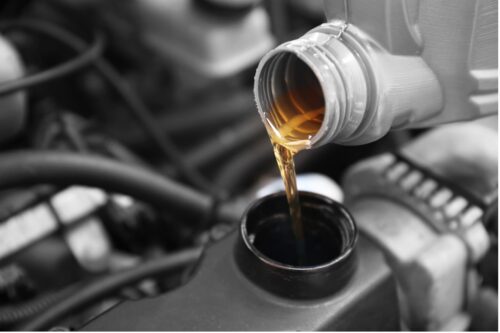An Expert Guide to Honda CR-V Oil and Fluid

Engine oil is essential in keeping all moving parts of your engine lubricated and operating accordingly. Without regularly topping up on engine oil, not only will you notice a reduced performance level in your Honda CR-V, but you may also be causing severe damage to your engine.
There is a range of different engine oils available on the market, some of which are conventional oil, while others are synthetic oil. To ensure the longevity of your Honda CR-V, you’ve got to select high-quality, genuine engine oil. You also need to invest in CR-V engine oil suitable for your engine capacity.
So, what oil does a Honda CR-V take? This article will identify the best Honda oils and fluids and detail how best to determine your car’s oil level. It will also go over how to perform oil changes and explore transmission fluid, differential fluid, and power steering fluid.
What engine oil should I use for a Honda CR-V?
The only engine oil types used for Honda CR-V engines are 0w-20 oil and 0w-30 oil. It’s also essential to choose an oil that is synthetic grade. Fully synthetic oil is better for your engine, has a longer life than regular oil, and helps your car reduce fuel consumption. It’s also important to choose a synthetic oil from a trusted brand.
The engine oil that your Honda CR-V takes depends on the type of engine it’s fitted with. So, you’ve first got to know what kind of engine you’ve got before buying synthetic oil. If you are unsure which type of synthetic oil to use, look at your car owner’s manual or read our Honda oil and fluid information guide.
How to check oil in a Honda CR-V
Engine oil keeps all the moving parts in your Honda CR-V lubricated and running smoothly. If you frequently use your car, you’ll need to check its oil levels regularly. Following our simple steps on how to check engine oil levels keeps your car healthy and ensures its safe to be on the road.
Step 1: Start the engine
The best time to check the oil life of your engine is when filling up your fuel tank or when preparing for long journeys. To do this, start your engine and wait until the normal operating temperature is reached.
Step 2: Stop the engine
Once you reach the normal operating temperature, switch the engine off again. Make sure your car is parked on a flat surface.
Step 3: Take out the dipstick
The dipstick is your most vital tool when checking the oil level of a car. Remove the dipstick, clean it, and then re-insert it.
Step 4: Hold the dipstick level
Remove the dipstick a second time and hold it level so that minimal oil drips from it, or runs up and down the stick.
Step 5: Read the dipstick
The oil level on the dipstick should be somewhere between the minimum and the maximum level indicators. Of course, the closer the oil line is to the maximum indicator, the more oil you’ve got in your car. If the line is close to the minimum indicator, you should top up on oil.
The space in between the minimum and the maximum indicators on the dipstick indicates around 1 litre of oil.
When should you top up the oil in your Honda CR-V?
Depending on the oil type you buy, Honda recommends that you should top up the oil in your Honda CR-V once every 3,000-5,000 miles. This is a big window, which is why it’s important to regularly check the oil level yourself using the dipstick.
You may have to change the oil in your Honda CR-V more regularly if you drive an older model, carry heavy loads, or if you regularly partake in sports driving. The conditions you drive through could also affect your oil change rate, with dustier roads impacting how much oil you go through.
How to top up Honda CR-V oil
If the oil level on your dipstick is close to the minimal indicator, it’s time to perform an oil change. Here’s how to top up your Honda CR-V with oil:
Step 1: Preparation
First, ensure that your car is parked on a flat surface. Next, make sure that you have the following tools and equipment:
- Engine oil (synthetic oils work best)
- Oil filter
- Oil funnel
- Oil filter wrench
- Wrench
- Oil drain pot
- Eyeglasses
- Gloves
Step 2: Drain the old oil
Performing an oil change is important to keep your car working smoothly, as leftover oil can damage your vehicle. To drain the old oil, first, make sure that your car has not been running for at least half an hour. This will give the engine oil enough time to cool down.
Once 30 minutes have passed, put gloves on, place the oil drain pot underneath the oil tank, and open the drain plug. Once drained, clean the drain plug and tighten the plug well.
Step 3: Put in a new oil filter
Use an oil filter wrench to loosen the old oil filter. It’s best to keep the oil drain pot underneath the oil tank, as excess oil can drip out during this stage. Once loosened, the old filter can be removed by hand.
Take the new filter and lubricate the seal with oil. Next, fill the new filter with 1/2 quart and screw it on by hand or by using the wrench. Avoid fastening the filter too tightly as this can deform the gasket rubber.
Step 4: Add engine oil
To add new engine oil, remove the cap located on the top of the engine and slowly pour in the oil. Make sure to do this slowly and avoid overfilling – you can use a funnel to make this stage easier. You can check the progress of your oil filling by using the dipstick to determine how close you are to capacity.
Once at capacity, reattach the cap. Make sure you run your engine for around 5 minutes before driving to let the oil circulate. After allowing it to circulate, you can check your dipstick to make sure that you have changed the engine oil successfully.
How to check transmission fluid in a Honda CR-V
You can check the transmission fluid in a Honda CR-V by referring to the transmission fluid dipstick.
How often to change transmission fluid in a Honda CR-V
You should change the transmission fluid in your Honda CR-V once every 90,000 miles. Otherwise, you should look out for common Honda oil leaks, delayed gear shifts, a grinding noise when you change gears, or the transmission warning light glowing.
How to change transmission fluid in a Honda CR-V
Transmission fluid is like engine oil in that it’s a lubricant, but it’s different because it also acts as a hydraulic fluid. Transmission fluid prevents corrosion, maintains fluid pressure, and cools inside the engine.
Here’s how to change the transmission fluid:
Step 1:
Before you start, drive your car for 5 to 10 minutes to let the oil warm up. When you’re ready, ensure your car is parked on level ground.
Step 2:
Open the access panel, which you’ll find under the front bumper on the driver’s side. You can do this by unscrewing the two head screws located near the front of the plastic panel.
Step 3:
With an oil drain basin underneath, open the fluid drain plug and let the old transmission fluid flow out. Give the plug and screw it back in.
Step 4:
Under the bonnet, remove the transmission dipstick and pour in the new transmission fluid. For advice on how much transmission fluid to add, follow the vehicle manual. Just like when changing engine oil, use the dipstick to determine when you have filled in a sufficient amount.
How to change power steering fluid in a Honda CR-V
Like engine oil, you must regularly change the power steering fluid in a Honda CR-V engine. Power steering fluid is used to lubricate the steering system’s moving parts and create a hydraulic link between the front wheels and the steering wheel. This makes turning the wheels easier. Power steering fluid should be changed at least once every 100,000 miles.
Here’s how to change the power steering fluid in a Honda CR-V:
Step 1: Open the bonnet of your car and find the white ABS power steering reservoir, which is located on the driver’s side.
Step 2: Open the top of the reservoir and use a fluid removal tool to remove the old power steering fluid. Dispose of the old fluid in a catch basin.
Step 3: Pour the new steering fluid into the plastic reservoir until full.
Step 4: Repeat this process weekly for around a month to ensure that all of the old power steering fluid has been removed.
FAQs
What oil is used for a Honda CR-V?
The best engine oil for Honda CR-V is genuine Honda engine oil. It is a fully synthetic oil, has low viscosity, doesn’t break down at high temperatures, and doesn’t cause sludge formations.
However, there are several alternative engine oil types that we’d recommend, including Castrol engine oil and Mobil 1 engine oil, both of which are examples of fully synthetic oil.
How often does the engine oil need topping up in a Honda CR-V?
You should perform an oil change once every 3,000-5,000 miles on a Honda CR-V using synthetic engine oil. However, a shorter oil change interval may be caused by the conditions you drive in, how you drive, and the age of your engine parts.
Is synthetic engine oil good for a Honda CR-V engine?
Synthetic engine oil is the best option for a Honda CR-V because it causes less friction in the engine, creates fewer impurities, and clears the engine of deposits.
Where can I buy high-quality CR-V engine oil?
You can buy high-quality Honda CR-V synthetic engine oil on the Cox Motor Parts website.
How often should you change brake fluid in a Honda CR-V?
You should change the brake fluid in a Honda CR-V once every three years.
Find replacement genuine Honda CR-V oils and fluids
At Cox Motor Parts, we only stock genuine Honda parts and accessories for a variety of vehicles, including Honda CR-V parts. Whether you need diesel engine oil or are looking for the right brake fluid for your Honda CR-V, we’re here to help.
Read some of our other guides for more maintenance tips, including our guides on how long Honda CR-V tyres last, how long Honda brake pads last and how often to change the power steering fluid in a Honda.






